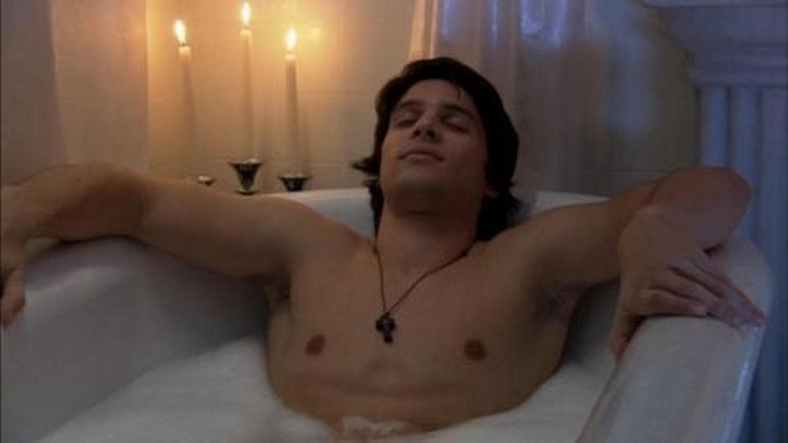David DeCoteau’s ‘House of Usher’ is the Horniest Poe Adaptation Out There

David DeCoteau’s House of Usher, from synopsis alone, sounds no better or worse than any number of Poe adaptations from the middle of the last century onward. Roger Corman’s 1960 adaptation remains one of the best Poe adaptations of all time, though several other filmmakers have tried their hand at one of Poe’s most gothic, macabre tales. Mike Flanagan has his own adaptation on the way, and recently, T. Kingfisher’s What Moves the Dead updated the classic horror text with ecological, fungal dread. David DeCoteau’s House of Usher is very, very different. DeCoteau also adapted Poe’s The Raven and helmed several other low-budget horror films before shifting into Lifetime-esque television thrillers, and like those early aughts titles, House of Usher is very, very gay.
I stumbled upon the movie in middle school. Before cell phones were ubiquitous and households, if they were lucky, shared a single desktop computer, I had to watch movie trailers on Comcast’s On Demand trailer channel. There, sorted from A-Z, was a list of titles—some old, some new—with trailers available. Often, I filtered this list to horror, and upon spotting House of Usher, I was curious. After watching the trailer, I was even more curious.
Also Read: The Ten Best Queer Relationships In Horror
House of Usher is softcore gay Poe-rn masquerading as gothic horror. It’s firmly R-rated, however, so House of Usher never penetrates carnal desire deeper than a steamy make-out session. Ian Shaw narrates some choice Poe lines with classic Hammer intonation, deep and baroque, and the broad outline remains the same. Michael Cardelle’s Victor Reynolds is urgently summoned to his friend Roderick Usher’s (Frank Mentier) house. Upon arriving, they reconnect, though in a matter of minutes, their shirts are off and their chiseled Abercrombie bodies are entwined on the floor.
The duration of House of Usher is mostly that. Exclusively white men with washboard abs arrive, strip down, passionately kiss others, and amble through the barest bones horror story. The opening scene, with its blue lights and Hitchcock-lite score, has trace elements of Mario Bava’s Blood and Black Lace, and the odd establishing shot of the manor’s interior and exteriors—spooky statues, black candelabras—satisfies the genre quotient. House of Usher regularly eschews its own mood for over-saturated lighting and late-night Cinemax wow-wow music. Because, again, it’s softcore porn. Despite a reported $1,000,000 budget, its preeminent focus is titillation, not coherence. Sure, the sexiness subsides in Act 3 (other than a very serious discussion between Victor and a shirtless gardener), and there’s some death and a twist ending, but that’s never really the point.
Also Read: And We Who Walk Here Walk Alone: The 60-Year Queer Gothic Legacy of ‘The Haunting ‘
There’s a change when Jaimyse Haft arrives in the second act as Madeline Usher, Roderick’s similarly ill sister, gamely assuring some oft-ignored horror bisexual representation. Mostly, however, in lieu of iciness, a sinking, or even a sickening of the heart there are instead stripteases, bulges, and semi-nude hunks hiding their erections behind some conveniently placed set decoration. It all seems quite silly (at one point, a teddy bear, uh, growls at a naked man), but there’s an innate charm to it, not to mention the notable legacy of DeCoteau.
DeCoteau, like Corman, has his strongest hits rooted in Poe. While the artistic integrity of both—especially in later decades—remains up for debate (and, yes, Corman is considerably more influential), it’s worth recontextualizing DeCoteau as a contemporary queer icon. In fact, DeCoteau was poached by Corman in the 1980s, getting his start as a production assistant at Corman’s New World Pictures. And, no, DeCoteau’s House of Usher is no Corman’s The Masque of the Red Death (a masterpiece). But as a champion of softcore gay horror, he’s worth celebrating.
The advent of the internet and the proliferation of online pornography has eroded the softcore market. The money has shifted away from nudie mags and Skinemax airings to digital hardcore pornography (hardcore here meaning explicit, no other connotation). In fact, most ostensible softcore pornography available today is simply hardcore porn edited down for accessibility.
Also Read: Queer Horror Creatives in Florida and Elsewhere Need Help
In the culture of sex positivity and pornography writ large, the efficacy of softcore pornography might seem difficult to argue. Some scholars posit the origin of softcore pornography as geared toward women, an audience that wanted sexual content without the more explicit elements. Porn scholars regularly argue that softcore pornography is the pornography of Third Wave Feminism. Whatever the purpose, in an era where erotic thrillers are on the decline and spicy, so-called “smut” literature is on the rise, it’s worth re-considering the value of DeCoteau’s aggressively queer and deeply silly House of Usher.
My experience watching it as an adult is considerably different than my perception as a teenager. Where a shirtless man covered in blood once incited curiosity, it now incites little more than laughs. It’s amusing to watch conventionally pretty, muscular men stumble through scenery, trying to deliver dialogue that’s both menacing and sexual. It’s as amusing a time as one can have with a movie, and for Pride Month, I emphatically encourage anyone with even a passing interest to check the title out. I’m not here to make the case that it’s high art or elevated in any sense (it isn’t). Instead, it’s unequivocally queer, an almost-celebratory ode to the male form, all wrapped in a gothic, Poe bow. It’s unlike anything else out there, and for that, it’s worth checking out.
Categorized:Editorials

